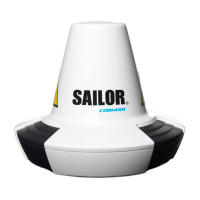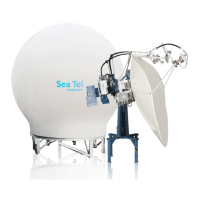Service
98-175666-C Chapter 4: Setup of the antenna 4-35
4. Select Enable in the section Azimuth calibration (active satellite profile).
5. Click Apply.
6. Switch on the modem.
Azimuth calibration (user controlled)
1. On the page SERVICE > Calibration, in the section Azimuth calibration (user
controlled), select User defined in the Satellite drop down list.
2. Type in the longitude of the satellite.
3. Type in its tracking frequency, 19.707 GHz.
4. Select Satellite identifier: GSC, NID, Orbital position (DVB-S, DVB-S2)
1
.
5. Click Start and wait typically 5 minutes for the azimuth calibration to finish. A
progress bar is shown during calibration and a message is displayed when the
Note
If you do not want to enter the satellite data on the calibration page you can
select a dedicated satellite service profile for calibration and select it.
Check that the satellite transponder is visible from the location of the
installation and that it is at an elevation angle between 5 and 85 degrees.
Satellite Position Frequency Polarisation Satellite identifier
GX1 –IOR 62.6 E 19.707 GHz LHC GSC
GX2 –AOR 55 W 19.707 GHz LHC GSC
GX3 –POR 179.6 E 19.707 GHz LHC GSC
GX4 –IOR 56.6 E 19.707 GHz LHC GSC
GX5 –EME 11.0 E 19.701 GHz LHC GSC
Table 4-20: Inmarsat GSC satellite information
Important
The calibration function is not able to verify the correctness or
precision of the supplied longitude. It is therefore important to supply
the correct longitude including the first decimal.
1. Use Orbital position and NID if you want to use NID or orbital position or other KA
band satellites with DVB-S2 support. The DVB symbol rate must be >5 Ms/s. For NID
use preferably a unique NID (ONID). An azimuth calibration without NID can be useful
in regions where the satellite operators do not broadcast NID (US, China, Australia
etc.). For NID=0 the NID is not used when checking the satellite link. For NID 1 to
65535 the supplied NID is matched against the Network ID broadcast by the satellite.
For orbital position the supplied longitude is matched with the orbital position
broadcast by the satellite. Not all service providers broadcast the orbital position.

